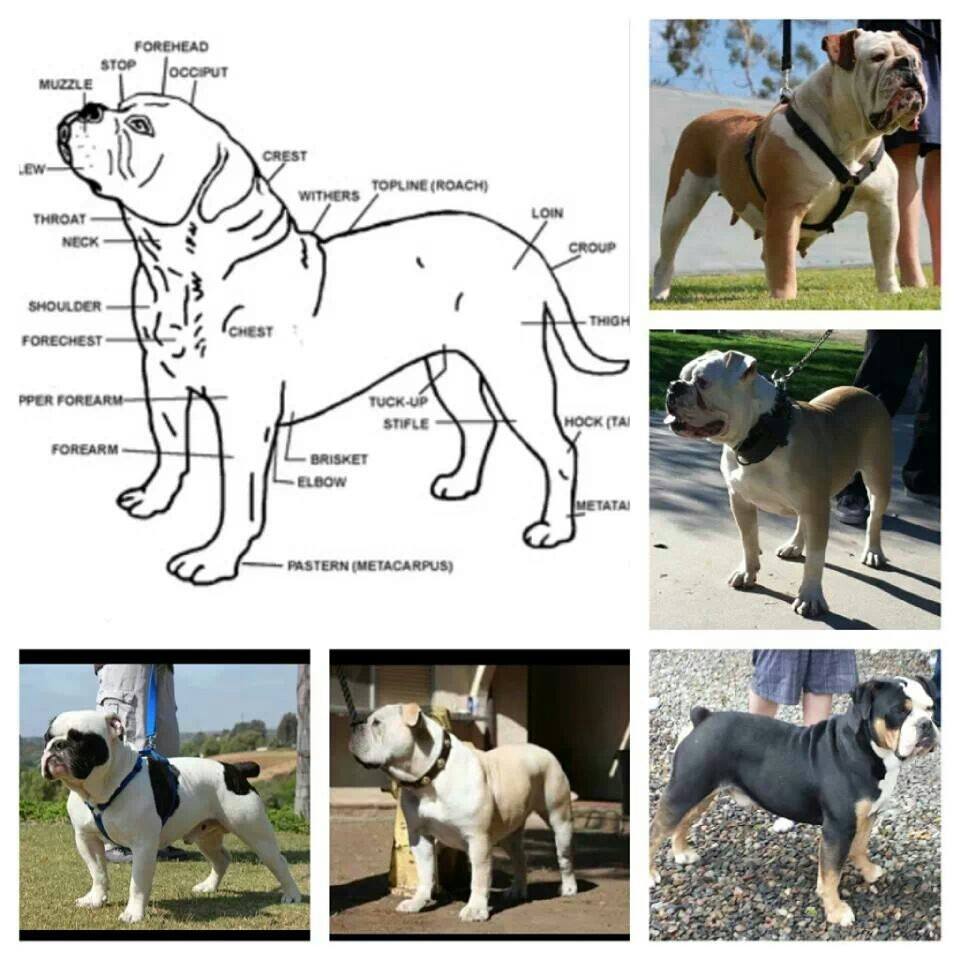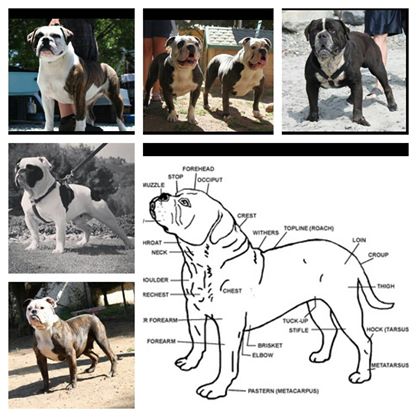Olde English Bulldogges Breed Standards
At One of a Kind Bulldogs, we are expertly aware of and follow all of the standards set by the International Olde English Bulldogge Association – IOEBA, Olde English Bulldogge Kennel Club – OEBKC, United Kennel Club – UKC and Continental Kennel Club – CKC for general description, temperament, and body for the dogs we help create and promote. We are professional, prideful and understand the quality attributes that are expected of us as breeders and of the product that we love. We also have dedicated our lives to this breed and it’s history. Follow our Bulldog History Facebook page and see how the Bulldog, one of the most reveared breeds has evolved.
The standards are:
GENERAL DESCRIPTION OF THE OLD ENGLISH BULLDOGGE
The ideal Olde English Bulldogge is considered to be a loyal (by your side and on your side at all times!) and courageous dog, medium in size with a large powerful head and a mighty, stout muscular body that promotes a strong friend. They are keenly active and most importantly of extremely good health. Male s are to be considered free breeders and females are always free whelpers. They are always to be devoid of all breathing issues and are capable of enjoying most if not all outdoor activity without concern (except in extreme heat or cold).
The temperament is one of the best characteristics of an Olde English Bulldogge and squarely separates him from other breeds. They are very stable, trustworthy and loving, making the breed a loyal companion and capable protector as well as the ultimate family member. Olde English Bulldogges thrive on serving, pleasing, and obeying their owners and are quick learners making them very trainable. The disposition should be outgoing, friendly and happy. While a watchful nature may be expected at home, human aggression without provocation is a disqualifying fault. The lifespan of the Olde English Bulldogge is between 10 and 14 quality years.
PHYSICAL DESCRIPTION OF THE OLD ENGLISH BULLDOGGE
HEAD: large and high, moderately sunken between the eyes (called the “medial furrow”). The circumference of the head should be equal to or greater than the Olde English Bulldogge’s height at the shoulder. A narrow head or one that appears too small for the body is a fault.
EARS: set well on the sides of the head. Dropped ears are acceptable as long they are small, not severely floppy or “hound like”. Full pricked ears that stand up on top of the head should be considered a serious fault.
MUZZLE: broad, deep, and short with moderate wrinkling. The bite is undershot with the bottom jaw turning up noticeably. If the muzzle is too long (more than 3 inches) scissor bite or even bite are disqualifying faults and not a qualified Olde English Bulldogge. Their muzzle should be no shorter than 1 ½ inches. Wry jaw is also a disqualifying fault.
BACK: males should appear square and balanced. Females should appear similar with consideration given for body length. Short with a very slight rise from the shoulders to a slight drop in the croup is preferred. A level back is acceptable as long as the tail does not come straight off the top of the back.
SHOULDERS: well laid back with significant angulation to allow for good movement. Straight shoulders are a fault.
FORELEGS: should be straight and wide apart, neither bowing out nor turning in to the center of the chest. There should be significant bone substance. Elbows should be relatively close to their stout body. Lacking bone and substance is very undesirable in this breed. Elbows that are loose or “fiddle fronts” are a disqualifying fault. “East / West” forelegs are a serious fault.
REAR LEGS: should exhibit significant bend of stifle to allow for good movement. They should be extremely muscular. Straight or “posty” rear legs are a serious fault of the breed, and are a disqualifying feature. Cow hocks are a disqualifying fault.
BODY MOVEMENT: a well-balanced gait that drives off the rear and is complimented by reach, allowing the dog to cover ground with a sense of power. Dogs should single track. Pacing or crabbing is a serious fault.
FEET: are round, tight both front and rear, and the pasterns should be strong. Weak pasterns and/or splayed feet are disqualifying faults.
*HEIGHT: Males – 17 to 20 inches at the shoulder. Females – 16 to 19 inches at the shoulder.
*WEIGHT: Males – 60 to 90 lbs. Females – 50 to 80 lbs.
*Although height and weight above the standard is to be discouraged, there is no penalty as long as the dog is well proportioned, otherwise correct and balanced.
COAT: Any color of coat is accepted for the Olde English Bulldogge except Merle. The coat is short. A wavy coat or a long coat is a disqualifying fault. There should be no signs of feathering on the legs or neck area, also a disqualifying fault.
TAIL: a pump handle tail that naturally reaches the hock is preferred, screwed short or a docked tails are acceptable. The pump handle tail should be carried low and not over the back of the Olde English Bulldogges back.
We at One of a Kind Bulldogs are dedicated to ensuring the highest quality standards of our dogs. We strive to maintain a level of integrity that is second to none in this industry. This is achieved by being committed to our animals and not compromising in any area of our devotion to this breed. We refuse to not lower the standards of of any of our internal procedures or care to save time or money during this process. We are completely transparent and open with everything that we do. At One of a Kind Bulldogs, we share the same character and behavioral traits with our canine family – excellence.
Olde English Bulldogges Breed History
The Bulldog breed began with the Alaunt, an extinct line of working dogs existing in ancient Asia and Europe. Around 1500 AD in France, Alaunts were separated into three distinct categories based on physical appearance and duties performed: 1) Alaunt Gentile – a greyhound-like dog, which was eventually assimilated with Alaunt Veantre; 2) Alaunt Veantre – local hunting breeds; and 3) Alaunt de Boucherie – a mastiff-like dog crucial in the development of fighting and baiting dogs. Alaunt de Boucherie were termed the original Bulldogs as they were used to control and defend cattle. By the 15th century, bulldogs were used in the “sport” of bull baiting. This entailed a bull having a rope tied around its horns and being staked to an iron in the center of the ring; subsequently, bulldog owners would set their dogs loose, baiting the bull/bear one at a time for about an hour.
During the Elizabethan Area, bull- and bear-baiting was extremely popular, attracting people from all classes of society. The participation in this “sport” made dog owners more conscious of the importance of the physical structure and size of the dog. This started the evolution of the bulldog; the dog began changing shape with the bulk of its weight near the head. Bull baiting was succeeded by dog fighting, which further gave way to the diminishing number of purebred Bulldogs. While bull baiting led to the crossbreeding of bulldogs for fierce, vicious, and tenacious traits, dog fighting led to the crossbreeding with the Terrier. This combination was thought to create a better fighting dog.
Up until law banned bull baiting and dog fighting in 1835, bulldogs were bred for aggression. Once bull baiting was outlawed in the United Kingdom, although there was essentially no further need for the breed, the exportation of bulldogs to the United States and Germany barred the breed from becoming extinct. In the United States, bulldogs continued to be a working breed, herding hogs and cattle. While in Germany, bulldogs were crossbred to eventually create the boxer.
In the early 1970s, David Leavitt developed the Olde English Bulldogge (OEB) breeding line. He developed the line to have the look, health, and athleticism of bull-baiting dogs, but without the extreme tenacity. He did this by crossing half English Bulldog with half Bullmastiff, American Pit Bull Terrier, and American Bulldog. By 1985, three true lines were developed and the breed was deemed sound, stable, and well suited for modern life. Early on, OEBs were used in Personal Protection training due to their excellent health, agility, temperament, and classification as a working breed. Although OEBs were qualified, this training made people question the intended use of the breed. During this time, Leavitt turned over the OEBA registry and personal breeding stock to Mike Walz of Working Dog, Inc.
Written by Brittney Gallina
- http://dogs.bsl-sbt.com/dogs/alauntnonbulldog.php?s=&l=
- http://www.cesarsway.com/newsandevents/dognews/The-History-of-Bulldogs
- https://sites.google.com/site/eng128placingthestage/student-research—landmarks-or-plces/bull-baiting
- http://www.bulldoginformation.com/bull-baiting.html
- http://oldeenglishbulldoggekennelclub.com/page11222625.aspx











